The Fascinating World of the Mountain Gorilla Nose
Mountain gorillas (Gorilla beringei beringei), majestic primates inhabiting the misty forests of Central Africa, are known for their robust build, social complexity, and striking physical features.
Among these, the mountain gorilla’s nose stands out as a unique and critical aspect of its biology. Far more than a mere organ for breathing, the nose plays a pivotal role in identification, communication, and survival.
Anatomy of the Mountain Gorilla Nose
The mountain gorilla’s nose is a distinctive feature, characterized by its broad, flat structure and prominent nostrils. Unlike humans, whose noses project outward, mountain gorillas have a more flattened nasal profile, adapted to their environment and lifestyle.
The nose consists of cartilage and soft tissue, with large, oval-shaped nostrils that facilitate efficient airflow. The skin around the nostrils is typically dark and slightly wrinkled, contributing to the unique “noseprint” of each individual gorilla.
Internally, the nasal cavity is lined with mucous membranes that warm and humidify inhaled air, protecting the respiratory system in the cool, damp forests of the Virunga Massif and Bwindi Impenetrable National Park.
The nasal passages are also equipped with olfactory receptors, though mountain gorillas rely less on smell than on vision and hearing compared to other mammals like dogs.
The structure of the nose is robust, suited to the gorilla’s herbivorous diet and active lifestyle, which involves foraging for leaves, stems, and bark at high altitudes.

The Noseprint: A Unique Identifier
One of the most remarkable aspects of the mountain gorilla nose is its role in individual identification. Much like human fingerprints, each gorilla has a unique noseprint—a pattern of ridges, creases, and shapes around the nostrils that remains consistent throughout its life.
Conservationists and researchers, such as those working with the Dian Fossey Gorilla Fund, use noseprints to identify and monitor individual gorillas in the wild.
This non-invasive method is critical for tracking population dynamics, studying social behaviors, and ensuring the safety of these endangered animals.
Photographing and cataloging noseprints is a meticulous process. Field researchers observe gorillas from a safe distance, capturing high-resolution images of their faces.
These images are then analyzed to distinguish subtle differences in nasal patterns. For example, one gorilla might have a deep crease above its left nostril, while another has a more symmetrical ridge pattern.
This identification technique has been instrumental in conservation efforts, allowing researchers to maintain detailed records of gorilla families, monitor health, and detect changes in population size.
The Nose in Communication
The mountain gorilla nose is also a key player in communication, particularly in the context of social interactions. Gorillas are highly social animals, living in cohesive groups led by a dominant silverback male.
While vocalizations like grunts, hoots, and chest-beating displays are well-known, the nose contributes to olfactory communication, albeit in a subtler way.
Gorillas produce scents through glands located near the nose and other parts of the body. These odors, though not fully perceptible to humans, convey information about an individual’s identity, reproductive status, and emotional state.
For instance, a silverback may use scent signals to assert dominance or attract mates. The large nostrils and sensitive nasal passages allow gorillas to detect these chemical cues, facilitating interactions within the group.
Additionally, the nose plays a role in vocal resonance. When a gorilla emits a hoot or roar, the nasal cavity amplifies the sound, giving it a deeper, more resonant quality.
This is particularly important for silverbacks, whose vocalizations must carry through dense forest to communicate with group members or warn off rivals. The nose, therefore, is not just a sensory organ but a tool for maintaining social bonds and group cohesion.
Ecological Adaptations
The mountain gorilla’s nose is finely tuned to its high-altitude habitat, which ranges from 2,200 to 4,300 meters (7,200 to 14,100 feet) in elevation. The cool, humid air of the montane forests requires efficient respiratory adaptations.
The broad nostrils and spacious nasal passages allow for rapid intake of oxygen, essential for an active primate that weighs up to 430 pounds (195 kg) and spends much of its day foraging and moving through rugged terrain.
The nose also aids in thermoregulation. By warming inhaled air, the nasal membranes prevent cold air from shocking the lungs, which is crucial in the chilly, misty environments where mountain gorillas live.
Furthermore, the nose filters out dust and plant particles, protecting the respiratory tract from irritation as gorillas feed on fibrous vegetation.
Interestingly, the mountain gorilla’s reliance on olfaction is less pronounced than in other primates, such as lemurs, due to their diet and environment.
Their herbivorous diet—consisting primarily of leaves, stems, and pith—does not require acute scent detection to locate food, as most plants are abundant and visually identifiable.
Nonetheless, the nose remains essential for detecting subtle environmental cues, such as the presence of predators or other gorilla groups.

Health and the Nose
The health of a mountain gorilla’s nose can provide insights into its overall well-being. Respiratory infections, which are a significant threat to gorilla populations due to their close genetic similarity to humans, often manifest in nasal symptoms like congestion or discharge.
Conservationists monitor these signs during routine health checks, as diseases like pneumonia can be devastating in small, interconnected populations.
Human activities, such as tourism and habitat encroachment, increase the risk of disease transmission to gorillas. For example, a common cold from a human visitor can lead to severe respiratory issues in a gorilla.
Conservation programs emphasize strict protocols, such as maintaining a minimum distance of 7 meters from gorillas and requiring masks for tourists, to protect the animals’ respiratory health, including their noses.
Conservation and the Broader Context
The mountain gorilla nose, while a small anatomical feature, is emblematic of the broader challenges facing this endangered species.
With only about 1,000 mountain gorillas left in the wild, primarily in Rwanda, Uganda, and the Democratic Republic of Congo, every aspect of their biology is critical to their survival.
The noseprint identification system has been a cornerstone of conservation efforts, enabling researchers to track individuals and assess population health without invasive methods.
Habitat loss, poaching, and human-wildlife conflict threaten mountain gorillas, and their noses indirectly reflect these pressures.
For instance, deforestation can alter the air quality in their habitat, increasing dust and pollutants that irritate their nasal passages.
Conservation initiatives, such as those led by the International Gorilla Conservation Programme(IGCP), work to protect gorilla habitats, ensuring clean air and abundant food resources that support their respiratory and overall health.
Cultural and Scientific Significance
Beyond their biological role, mountain gorilla nose have captured the imagination of scientists and the public alike. The uniqueness of noseprints underscores the individuality of each gorilla, reminding us of their complex personalities and social structures.
Popular media, including documentaries like Gorillas in the Mist, have highlighted the work of researchers who use noseprints to study these animals, bringing global attention to their plight.
Scientifically, the nose offers a window into evolutionary biology. Mountain gorillas diverged from their lowland relatives millions of years ago, and their nasal anatomy reflects adaptations to their specific environment.
Comparative studies of gorilla subspecies reveal slight variations in nose shape and function, providing clues about how environmental pressures shape physical traits.
Conclusion
The mountain gorilla nose is far more than a simple anatomical feature. It is a tool for survival, a marker of individuality, and a key to understanding the species’ ecology and behavior.
From its role in breathing and communication to its use in conservation and research, the nose encapsulates the challenges and wonders of mountain gorilla life.
As we continue to learn about these remarkable primates, their noses remind us of the delicate balance between biology and environment—and the urgent need to protect them for future generations.
By supporting conservation efforts, respecting their habitats, and advancing scientific research, we can ensure that the mountain gorilla nose—and the extraordinary creatures it belongs to—continues to thrive in the wild.